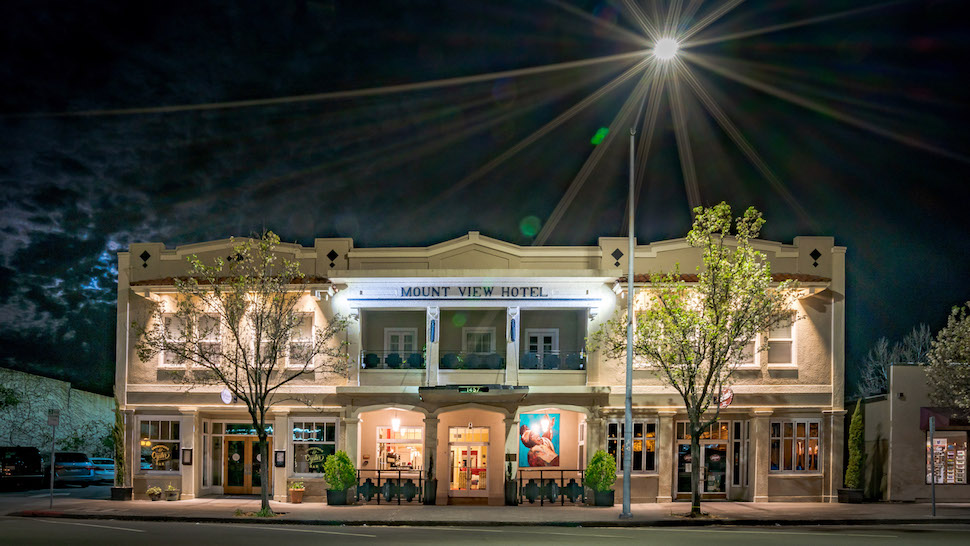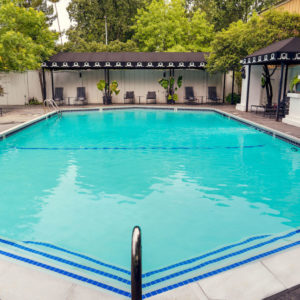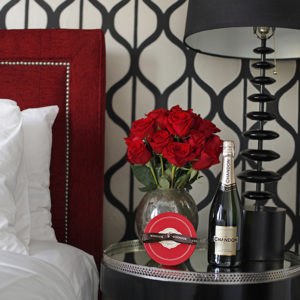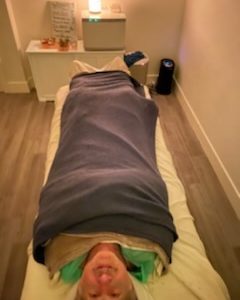
My body/mind have had a love affair with Calistoga, a little town (population 5,200; 2.5 square miles) at the northern end of California’s Napa Valley, famous for its natural hot mineral waters and mud baths and award-winning wines, since I first visited it some 40 years ago. Since I live only 70 miles away from my home, I go there several times a year to relax my aching muscles and rest my overactive mind. And I’ve written about it many times, including for InsidersGuidetoSpas.com.
 Over those years I’ve learned a lot from local friends about nooks and crannies most visitors never see. A local spa owner once took me to a dead-end side street to see his secret stash of volcanic ash, which he mixes with water and peat moss to make mud. I had as awe-inspiring a spiritual moment as I’ve experienced anywhere in the world on a visit to the Holy Assumption Monastery, a few blocks from the main drag, standing inside a tiny jewel-like wooden church, built in 1919 and now run by nuns of the Orthodox Christian Monasticism order who also sell their own label wines, home-baked goodies, and more. I’ve hiked the five-mile trail to the summit of Mount Saint Helena, overlooking the whole of Napa Valley, in Robert Louis Stevenson State Park, named after the author of “The Silverado Squatters,” in which he wrote the line “. . . and the wine is bottled poetry.” The line adorns a sign that looks like a wooden wine barrel, welcoming visitors to Napa as they drive north along Route 29. And of course, I’ve soaked in pools and tubs at some of the town’s oldest spas.
Over those years I’ve learned a lot from local friends about nooks and crannies most visitors never see. A local spa owner once took me to a dead-end side street to see his secret stash of volcanic ash, which he mixes with water and peat moss to make mud. I had as awe-inspiring a spiritual moment as I’ve experienced anywhere in the world on a visit to the Holy Assumption Monastery, a few blocks from the main drag, standing inside a tiny jewel-like wooden church, built in 1919 and now run by nuns of the Orthodox Christian Monasticism order who also sell their own label wines, home-baked goodies, and more. I’ve hiked the five-mile trail to the summit of Mount Saint Helena, overlooking the whole of Napa Valley, in Robert Louis Stevenson State Park, named after the author of “The Silverado Squatters,” in which he wrote the line “. . . and the wine is bottled poetry.” The line adorns a sign that looks like a wooden wine barrel, welcoming visitors to Napa as they drive north along Route 29. And of course, I’ve soaked in pools and tubs at some of the town’s oldest spas.
So it was to my surprise—and embarrassment—when I read that Calistoga has a new spa . . . which is actually an old spa reimagined. That would be the Mount View Hotel’s True Spa, which is hiding in plain sight smack dab in the middle of downtown. It had been called Spa Sante, managed by Loma Alexander, well-known Northern California spa developer and consultant, until she retired recently. Two of her highly regarded and experienced staff members, Janneke Byrne and Kelsy Keenan, have worked out a sweet deal with the hotel owners, the hospitably charming Michael and Stephanie Woods, to create a unique partnership wherein the Woods still own the spa but the women share in profits and have complete autonomy conceiving and operating True Spa.
Steeped in Calistoga History
A brief word about the Mount View Hotel, steeped in Calistoga history. First reconstructed after the fire of 1908, and called the European Hotel, it was acquired in 1915 by the hotel manager, Johnny B. Ghisolfo, who later became the mayor of Calistoga. (The bar/restaurant off to one side of the hotel is named Johnny’s after him . . . would’ve named it Johnny B Goode.) Johnny moved the hotel off the street front and built the Mount View in front of it in Mission Revival. At its lowest perhaps, in the late 1960s, it was a transient hotel for former prisoners just out of jail. Over the ensuing years it went through several hands; in 1981, it was added to The National Register of Historic Places. When Michael and his partners in real-estate development bought the hotel in 1990, they saw it as an investment, to refurbish and flip after a few years. But when he married Stephanie, his second wife, she saw it as a keeper. He bought out his partners in 2007, and the couple went to work enhancing the Art Deco style and bringing back a lot of other touches, including reconnecting the jacuzzi to the underground geothermal springs that course unseen through the town. That was when it became a family-run hotel. Today the 33-room property proudly represents a quintessential example in the boutique-hotel category.
First reconstructed after the fire of 1908, and called the European Hotel, it was acquired in 1915 by the hotel manager, Johnny B. Ghisolfo, who later became the mayor of Calistoga.
 Michael, who had also been a construction contractor, handled redesigning the spa area. Not an easy feat with a small space to work in, in an age when spas today boast grandiose reception desks and lounge areas that give the Garden of Eden a run for its money. To save space, the check-in reception desk is in the adjacent hotel lobby across from the spa entrance. Inside, there are four treatment rooms and a changing room; during Covid they’re allowing only one couple or group in at a time. A few new treatment rooms are under construction, as well as a separate sauna enclosure near the pool area and jacuzzi behind the hotel.
Michael, who had also been a construction contractor, handled redesigning the spa area. Not an easy feat with a small space to work in, in an age when spas today boast grandiose reception desks and lounge areas that give the Garden of Eden a run for its money. To save space, the check-in reception desk is in the adjacent hotel lobby across from the spa entrance. Inside, there are four treatment rooms and a changing room; during Covid they’re allowing only one couple or group in at a time. A few new treatment rooms are under construction, as well as a separate sauna enclosure near the pool area and jacuzzi behind the hotel.
“Spa” in Refreshingly Simple Language
Janneke, whose background (other than a philosophy degree from UC Berkeley) is spa management, oversees all operations. Kelsy Keenan, a licensed esthetician and yoga instructor, is more involved with menu development and staff training. Together the pair agreed from the get-go that the treatment offerings would not overwhelm guests with too many options. They also have minimized what they call “a lot of spa verbiage we found to be too flowery, winded, and convoluted” that ultimately either goes over people’s heads or under them. “We use language that’s easily digestible for the normal person,” said Janneke.
Their menu is relatively stripped down, compared to what many spas now offer. There are only five body therapies, eight “enhancements” (facials, stones, reflexology, etc.), four aromatherapies, three mud scrubs, and eight types of skincare (more facials and skin enhancements). For the mud, they use bentonite clay, which has zero aroma, contains natural anti-inflammatory properties, and is naturally detoxifying.
Another quality that the two consciously chose to distinguish True Spa from the other seven or eight spas in town: they’ve designed original treatments that spin off of traditional approaches. One example is their revisioning of the traditional Hawaiian lomi lomi massage, in which practitioners massage with the palms, forearms, fingers, knuckles, elbows, knees, feet, even sticks and stones. Theirs is called Loma Loma, an homage to their mentor Loma Alexander. Their version uses only hands to apply light pressure from head to toe in waves that gently ebb and flow, to stimulate and increase lymphatic drainage.
The California of Body Wraps

The author, happily cocooned
With adaptation in mind, and since True Spa doesn’t offer my fave traditional mud baths, I chose their Lemon Matcha Mud Cocoon, dubbed the “California of our body wraps.” Rosa Vazquez, their “star” practitioner (a star well deserved!), applied a hydrating Lemon Verbena scrub; it helps alleviate digestive disorders—indigestion, gas, colic, diarrhea, and constipation, as well as reduce agitation, joint pain, and much more. She then swabbed me with a layer of Matcha (yes, Matcha, the high-grade green tea ground into powdered form and traditionally sipped during Japanese tea ceremony) mixed into mud, giving anti-inflammatory benefits.
Then she wrapped me in a biodegradable plastic blanket, my own personal sweat lodge, opening my pores to let the ingredients penetrate my skin. Their website menu promises: “Your body and mind will be West Coastin’.” I’m not sure if that happened to me, but I floated out to the pool area as if on a cloud to lounge and absorb it all in a blissy state. I was treated to their first Sunset Wine Down Experience, a poolside charcuterie with cheeses, breads, hummus, and other nibbles, washed down with a glass of local wine (inclusive with the $230 fee for the Lemon Matcha Mud Cocoon treatment).
After that, it was all I could do to walk out the front door to any number of restaurants. So on second thought, I guess I was West Coastin.’
The next morning, full of energy, I rose early and sat in the backyard jacuzzi filled with hot mineral-filled waters tapped from the town’s underground springs. I espied a message on the nearby wall that spoke volumes in the fewest possible words: “Taking the Waters is beneficial and healing in many ways, especially for cleansing the body, relaxing the heart, refreshing the mind, and purifying the body.”
Unflowery, it nonetheless rang so true.
Perry Garfinkel
Contributing Editor Perry Garfinkel, who has been covering cutting-edge health and psychology trends for almost 40 years, is the author of the national bestseller Buddha or Bust. A longtime contributor to The New York Times, he has also written for the National Geographic Magazine, the AARP magazine, and the L.A. Times mind/body section, among others. The author of Travel Writing for Profit and Pleasure he leads writing workshops around the world and is a frequent guest on WCBS-NY radio’s Health & Well Being Report.